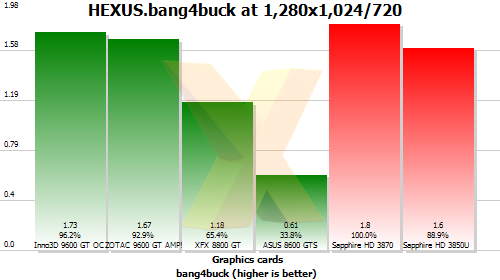HEXUS.bang4buck, temps and overclocking
HEXUS.bang4buck
In a rough-and-ready assessment of the cards' bang per buck, we've aggregated the 1,280x1,024/720 frame-rates for the three games, normalised them* and taken account of listed the cards' prices.
But there are more provisos than we'd care to shake a stick at. We could have chosen three different games, the cards' prices could have been derived from other sources and pricing tends to fluctuate daily.
Consequently, the table and graph below highlight a metric that should
only be used as a yardstick for evaluating comparative performance with
price factored in. Other architectural benefits are not covered,
obviously.
| Graphics cards | Inno3D GeForce 9600 GT OC 512MiB | ZOTAC GeForce 9600 GT AMP Edition 512MiB | XFX GeForce 8800 GT Alpha Dog Edition XXX 256MiB | ASUS GeForce 8600 GTS 256MiB | Sapphire Radeon HD 3850 Ultimate 512MiB | Sapphire Radeon HD 3870 512MiB |
|---|---|---|---|---|---|---|
| Actual aggregate marks at 1,280x1,024/720 | 230.33 | 237.53 | 178.19 | 88.38 | 185.12 | 210.94 |
| Aggregate marks, normalised*, at 1,280x1,024/720 | 190.51 | 195.73 | 141.26 | 54.1 | 158.04 | 175.96 |
| Current price | £110 | £117 | £120 | £89 | £99 | £98 |
| HEXUS.bang4buck score at 1,280x1,024/720 | 1.732 | 1.673 | 1.178 | 0.608 | 1.596 | 1.796 |
| Acceptable frame rate (av. 60fps) at 1,280x1,024/720 | No (CoH DX10) | No (CoH DX10) | No (CoH DX10) | No (CoH DX9/10, ET, LP) | No (CoH DX10) | No (CoH DX10) |
* The normalisation refers to taking playable frame rate into account. Should a card benchmark at over 60 frames per second in any one game, the extra fps count as half. Similarly, should a card benchmark lower, say at 40fps, we deduct half the difference from its average frame rate and the desired 60fps, giving it a bang4buck score of 30 marks. The minimum allowable frame rate is 20fps but that scores zero.
As an example, should a card score 120fps we treat it as 90fps as only half the frame rate above 60fps is counted for the bang4buck - this is the formula: (120-((120-60)/2)). Similarly, should it score 30fps, we count it as only 15fps: (30+((30-60)/2)).
The reasoning behind such calculation lies with playable frame rates.
Should card A score 110fps in a benchmark and card B 160, then card B would otherwise receive an extra 50 marks in our bang4buck assessment, even though both cards produce perfectly playable frame rates and anything above 60fps is a bonus and not a necessity for most.
Similarly, without our adjustments, the aggregated bang4buck total for two very different cards would be identical if, in a further benchmark, card A scored a smooth 70fps and card B an unplayable 20fps. Both would win marks totally 180, yet the games-playing experience would be vastly different.
A more realistic (and useful) assessment would say that card A is better because it ran smoothly in both games - and that view would be accurately reflected in our adjusted aggregation, where card A would receive 150 marks (85+65) and card B 100 (100+0).
In effect, we're including a desired average frame rate, in this case 60, and penalising lower performance while giving frame rates higher than 60fps only half as much credit as those up to 60fps. If this doesn't make sense or you have issue with it, please hit the HEXUS community.
Here's the HEXUS.bang4buck graph at 1,280x1,024/720.

The graph divides the normalised score by the price.
What the graph shows is that all 512MiB-equipped cards do well with value taken into account. The extremely attractive price of the Radeon HD 3870 512MiB makes it the pick up the bunch, however.
Temperature musings
| Graphics cards | Inno3D GeForce 9600 GT OC 512MiB | ZOTAC GeForce 9600 GT AMP! | ZOTAC GeForce 8800 GT AMP! | Sapphire Radeon HD 3850 |
|---|---|---|---|---|
| Ambient temperature | 19.5°C | 19°C | 21°C | 18°C |
| Idle temperature | 39°C | 41°C | 52°C | 45°C |
| Load temperature | 61°C | 63°C | 74°C | 73°C |
| Ambient-to-load delta | 41.5°C | 44°C | 53°C | 55°C |
Inno3D's card is a cool customer, running well below the GPU's threshold, suggesting optimistic frequency scaling.
Overclocking.
Default-clocked GeForce 9600 GTs ship with 650/1,625/1,800MHz clocks.
The Inno3D OC does so at 700/1,680/1,900MHz, as we noted earlier.We managed to raise the core to 750MHz, 1,800MHz for the 64 stream processors, and memory up to an effective 2,190MHz, down from the 788/1,902/2,200MHz achieved on the ZOTAC card.
Re-running Enemy Territory: Quake Wars at 1,680x1,050, the card's performance increased from an average 59.83fps to 63.93fps - or around seven per cent.









